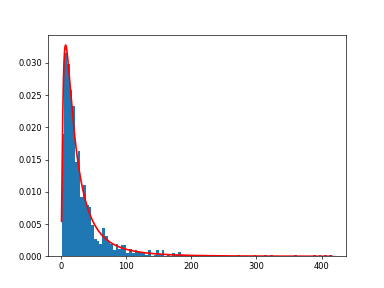nlcpy.random.Generator.lognormal
- Generator.lognormal(self, mean=0.0, sigma=1.0, size=None)
Draws samples from a log-normal distribution.
Draws samples from a log-normal distribution with specified mean, standard deviation, and array shape. Note that the mean and standard deviation are not the values for the distribution itself, but of the underlying normal distribution it is derived from.
- Parameters
- meanfloat, optional
Mean value of the underlying normal distribution. Default is 0.
- sigmafloat, optional
Standard deviation of the underlying normal distribution. Must be non-negative. Default is 1.
- sizeint or tuple of ints, optional
Output shape. If the given shape is, e.g.,
(m, n, k), thenm * n * ksamples are drawn.
- Returns
- outndarray
Drawn samples from the parameterized log-normal distribution.
注釈
A variable x has a log-normal distribution if log(x) is normally distributed. The probability density function for the log-normal distribution is:
where
is the mean and
is the standard deviation of the normally distributed logarithm of the variable.
制限事項
If mean is neither a scalar nor None : NotImplementedError occurs.
If sigma is neither a scalar nor None : NotImplementedError occurs.
Examples
Draw samples from the distribution:
>>> import nlcpy as vp >>> rng = vp.random.default_rng() >>> mu, sigma = 3., 1. # mean and standard deviation >>> s = rng.lognormal(mu, sigma, 1000)
Display the histogram of the samples, along with the probability density function:
>>> import matplotlib.pyplot as plt >>> count, bins, ignored = plt.hist(s.get(), 100, density=True, align='mid')
>>> x = vp.linspace(min(bins), max(bins), 10000) >>> pdf = (vp.exp(-(vp.log(x) - mu)**2 / (2 * sigma**2)) ... / (x * sigma * vp.sqrt(2 * vp.pi)))
>>> plt.plot(x, pdf, linewidth=2, color='r') ... >>> plt.axis('tight') >>> plt.show()
